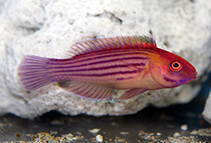| Family: |
Labridae (Wrasses), subfamily: Cheilininae |
| Max. size: |
6.91 cm SL (male/unsexed) |
| Environment: |
reef-associated; marine; depth range 60 - 110 m |
| Distribution: |
Western Central Pacific: Palau and Micronesia. |
| Diagnosis: |
Dorsal spines (total): 11-11; Dorsal soft rays (total): 9-9; Anal spines: 3-3; Anal soft rays: 9-9; Vertebrae: 25-25. This species is distinguished by the following characters: D XI,9; A III,9; pectoral fin rays 15; dorsal fin with progressively longer spine where the 11th is 2.4-2.6 in head; in males the interspinous membranes do not extend above the spine tips; pelvic fins of male short 4.05-4.9 in SL; rounded to rhomboid caudal fin; lateral line scales 16-17 + 5-6; median predorsal scales 4-5; cheeks with 2 horizontal rows of scales; colour in life pale red, shading to pale yellow on abdomen, with deep red longitudinal lines on body following scale rows (persists as lavender to purple when preserved); head with two deep pink bands, one from upper lip passing over eye to origin of dorsal fin, the other from lower lip along mandible to corner or preopercle; operculum yellow; dorsal fin yellow anteriorly with a black spot on first membrane, spines red; rest of fin and caudal fin light red with deep red rays; pelvic fins yellow with red spines and rays (Ref. 41654). |
| Biology: |
Inhabits mixed coral, rubble, and sand slopes along the bases of steep protected seaward reefs (Ref. 37816). Maximum depth reported taken from Ref. 128797. |
| IUCN Red List Status: |
Least Concern (LC); Date assessed: 25 March 2009 Ref. (130435)
|
| Threat to humans: |
harmless |
Source and more info: www.fishbase.org. For personal, classroom, and other internal use only. Not for publication.
